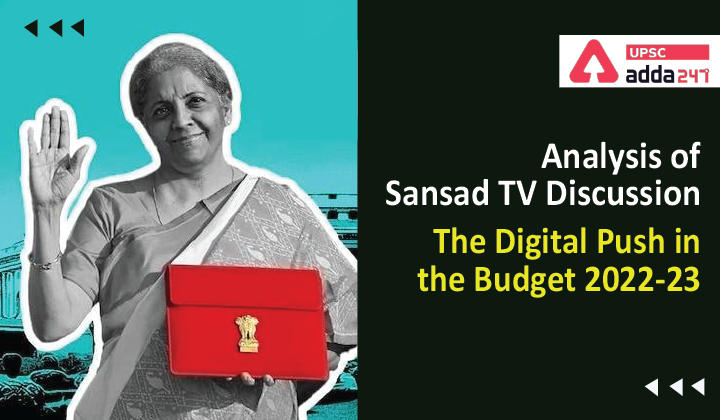Table of Contents
The Digital Push in the Budget 2022-23
Relevance
”GS 3 & GS 2: Government Budgeting, Parliament, Executive”
Introduction
- The government proposed several initiatives, with technology as the pivot, to boost a wide swathe of sectors such as skilling, agriculture, education, mental health, logistics or bolstering small and medium enterprises.
- Digital and IT have been given a central place in the Budget.
- It is one of the four pillars of governance. Be it logistics, health, education, language translation, IT has been given an important place.
Key areas in which digital push was given
5G
The government plans to roll out 5G services within the next financial year. It also aims to take optical fibre networks to remote corners of the country to enhance access to e-services.
Digital Economy
To further boost the digital economy, a digital rupee, using blockchain and other technologies, will be issued by the Reserve Bank of India from this financial year.
Digital Banking
To take digital banking to every corner of the country and to mark 75 years of Independence, the Budget proposes setting up 75 Digital Banking Units in 75 districts.
E-Passport
The decision to introduce E-Passport will further streamline the overall citizen experience, enhance security, and facilitate smoother international travel.
Drone Shakti
- The government also announced a big thrust toward using drones and start-ups will be encouraged to launch a ‘Drone Shakti’ project to facilitate drone usage through varied applications and also allow for usage of drones “as a service”.
- FM also announced the use of drones by farmers for land surveying, spraying of insecticides and digitisation of land records.
Digital Push in Education Sector
- In school education, acknowledging learning losses due to the closure of schools, the ‘one class-one TV channel’ programme of PM eVIDYA will be expanded from 12 to 200 TV channels.
- This will help state governments to provide supplementary education in regional languages for classes 1 to 12.
- It is a big step in providing high-quality e-content in all spoken languages for delivery via the Internet, mobile phones, TV and radio through digital teachers.
- A competitive mechanism for the development of quality e-content by teachers has been mentioned it will empower and equip them with digital tools of teaching and facilitate better learning outcomes.
- On the higher education front, a digital university will be established to provide access to students, across the country, world-class quality universal education with a personalised learning experience at their doorsteps.
- This will be made available in different Indian languages and information and communication technology (ICT) formats. The university will be built on a networked hub-spoke model, with the hub building cutting-edge ICT expertise. The best public universities and institutions in the country will collaborate as a network of hub-spokes
DESH-Stack e-portal
- In skilling and vocational education, the Digital Ecosystem for Skilling and Livelihood (the DESH-Stack e-portal) will be launched with an aim to empower citizens to skill, reskill or upskill through online training.
- It will also provide API-based trusted skill credentials, payment and discovery layers to find relevant jobs and entrepreneurial opportunities.
Possible Benefits of Digital Push
- The central digital university with a hub-and-spoke arrangement could well serve the need for remote learning in the digital space. If this is well-planned and leveraged, this could be a boon for those who cannot have access to the formal university education system and change the higher education landscape in India.
- The DESH portal could bring about a similar revolution in the upskilling and life-long skilling space. With the rapidly changing skill requirement across job functions, the ease of creating, learning and recognition could change the skilling landscape for many sectors—particularly for small and medium organisations.
- The convergence of digital channels and vernacular push in school education will be a model for many countries with large, dispersed learners.
- Apart from this, proper utilisation of allocations this year would mark the beginning of changes mentioned in the NEP 2020.
Conclusion
While these are good measures, a separate allocation for enhancing digital infrastructure—particularly in rural India, which would have been crucial for the development of digital infrastructure.



 TSPSC Group 1 Question Paper 2024, Downl...
TSPSC Group 1 Question Paper 2024, Downl...
 TSPSC Group 1 Answer key 2024 Out, Downl...
TSPSC Group 1 Answer key 2024 Out, Downl...
 UPSC Prelims 2024 Question Paper, Downlo...
UPSC Prelims 2024 Question Paper, Downlo...




